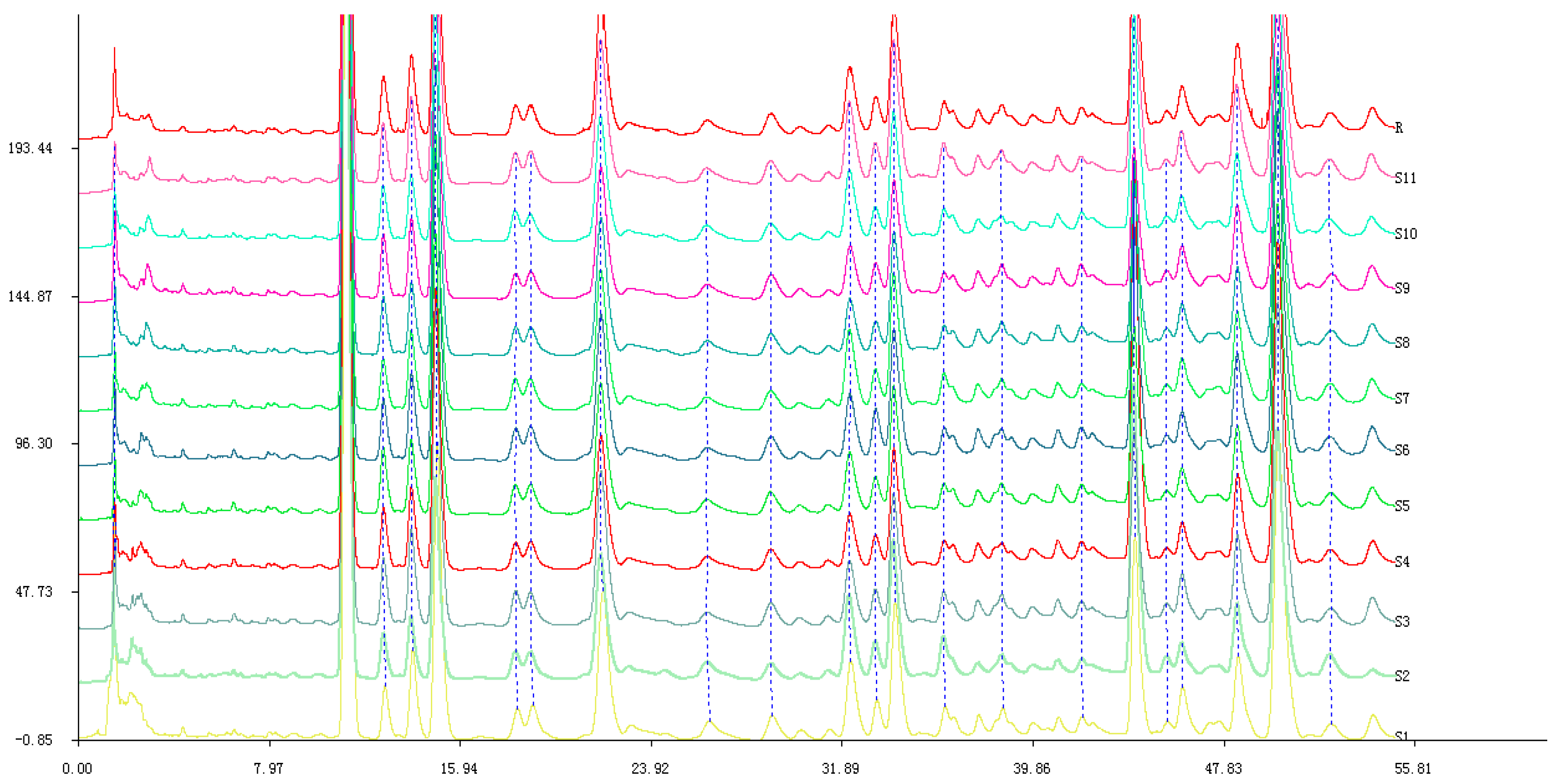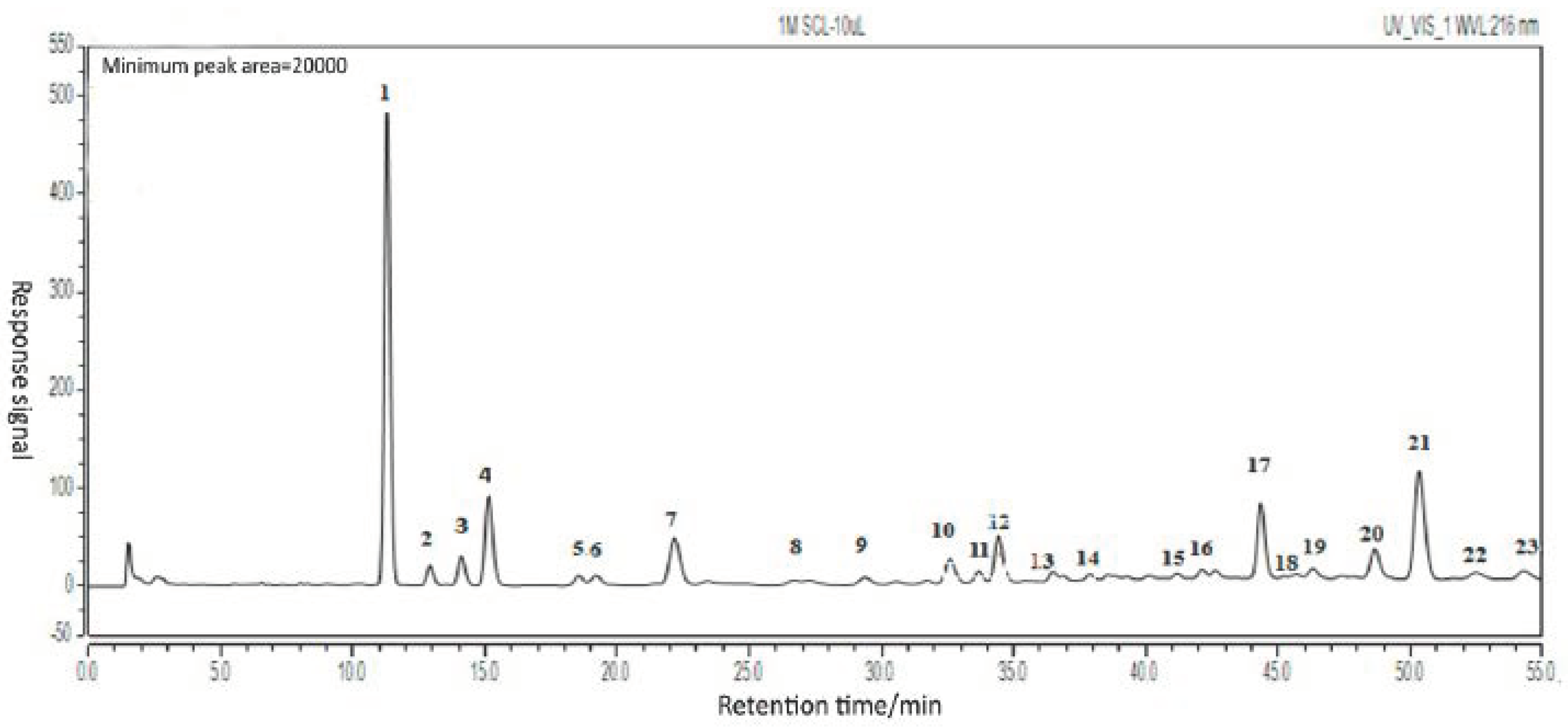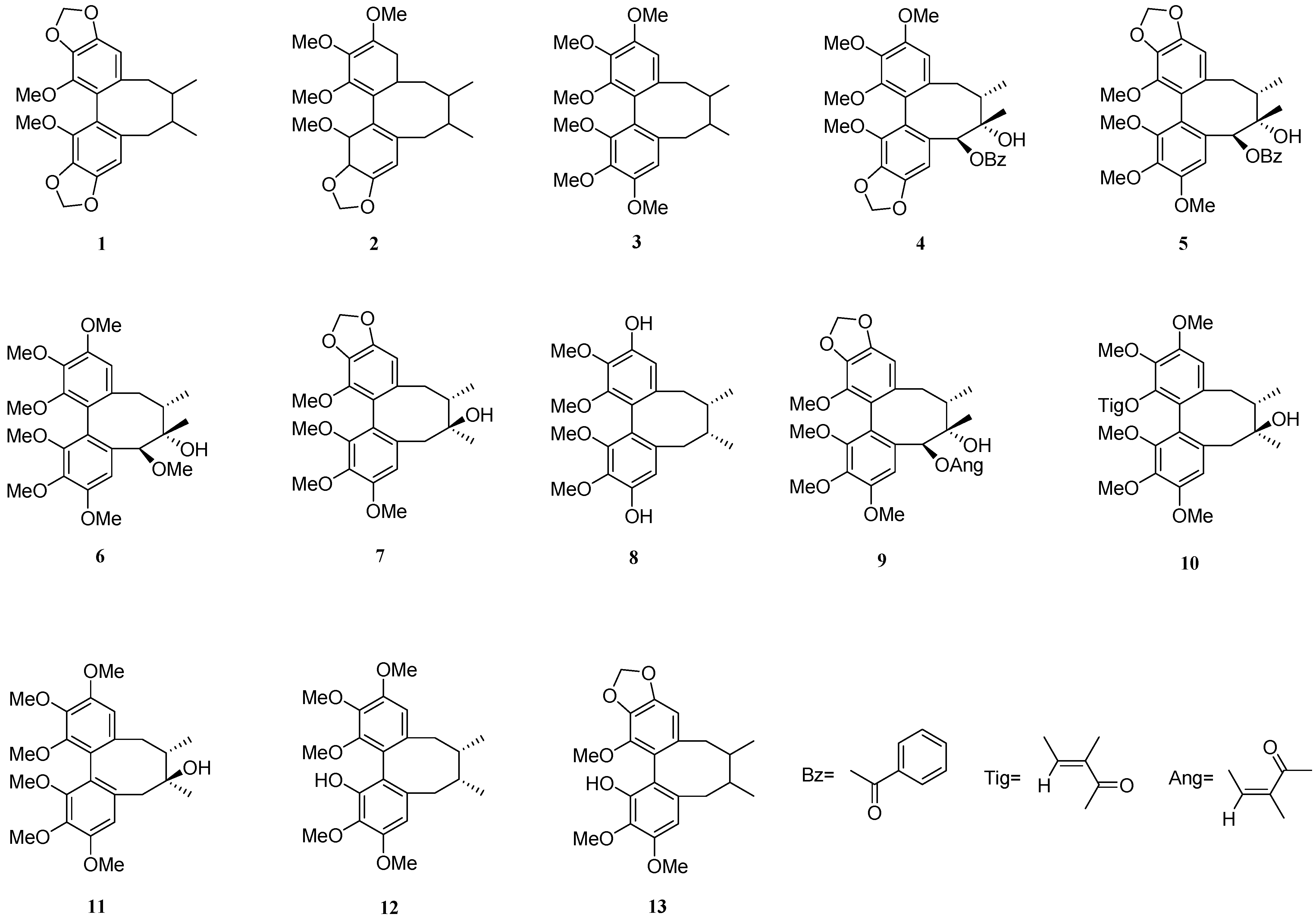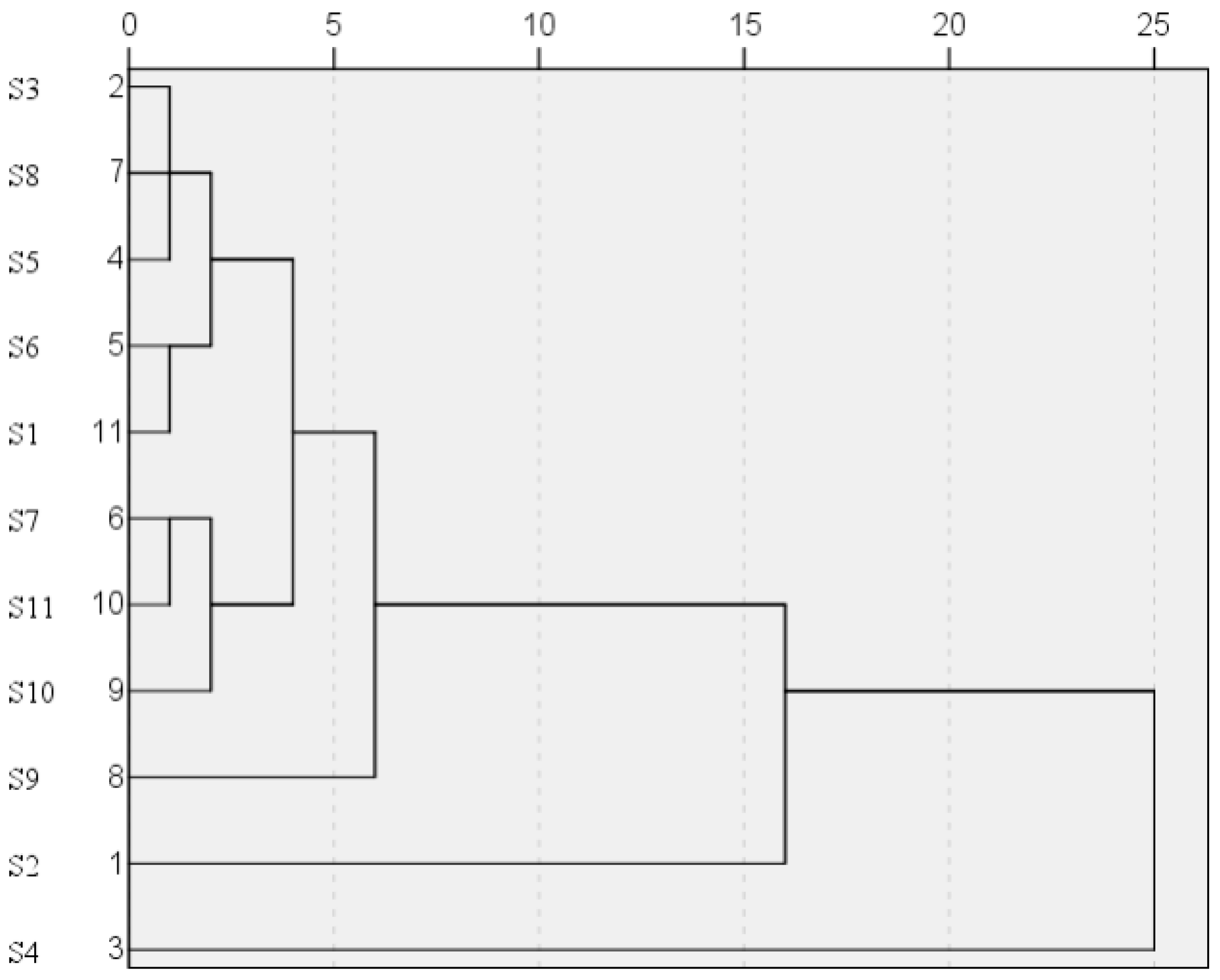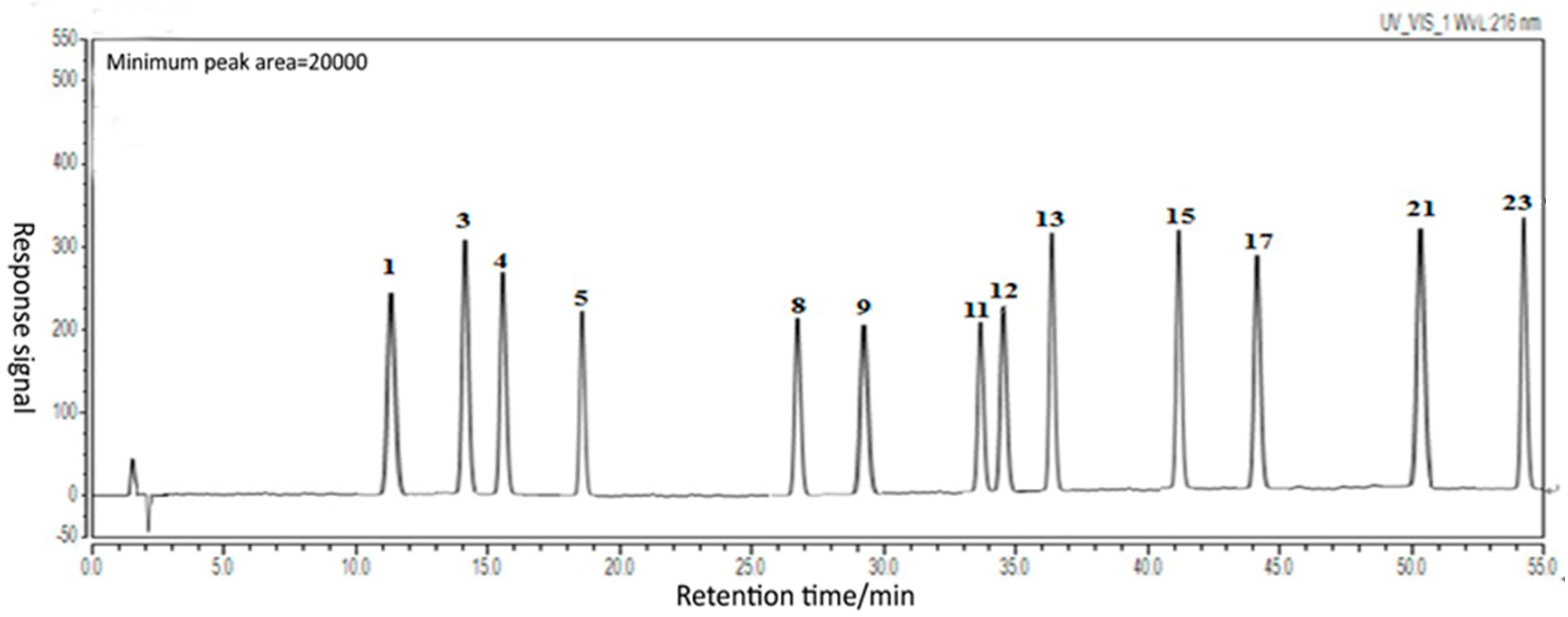1. Introduction
The dry fruit of
Schisandra chinensis (Turcz.) Baill. is a basic source plant of Fructus Schisandrae chinensis and is officially listed in the Chinese Pharmacopoeia. As a well-known traditional Chinese medicine (TCM),
S. chinensis has five flavors, including sour, sweet, bitter, spicy, and salty. Therefore, it is usually called Wuweizi [
1].
S. chinensis is mainly distributed in Liaoning, Jilin, and Heilongjiang provinces and the North China region. A modern pharmacological study of dibenzocyclooctadiene lignans showed that they had many biological functions, such as liver protection, reduced enzyme levels, antibacterial, antitumour, antioxidant, antiviral effects, and immune enhancement [
2,
3,
4,
5,
6]. Furthermore, it is noteworthy that
S. chinensis has been prescribed as a medication for the treatment of liver damage in TCM for thousands of years. In recent years, as a result of chemical and pharmacological research, it was shown that the dibenzocyclooctadiene lignans in
S. chinensis were the main hepatoprotective constituents [
7,
8,
9,
10,
11,
12], and an enrichment technique for the total dibenzocyclooctadiene lignans (TDL) from
S. chinensis was reported [
13,
14]. However, the correlation between the active dibenzocyclooctadiene lignans and their hepatoprotective activities was not clear, especially regarding which lignans are synergistic with respect to the activity and which lignans are less effective.
More and more studies have shown that the efficacy of TCM is due to the comprehensive synergistic effect of multiple specific targets in the material. In recent years, the spectrum-effect relationship has become an important technical means of combining the qualitative basis and curative effect of TCM. TCM fingerprint information can be combined with drug effect information, which has provided new ideas for elucidating the effective mechanism of TCM by screening out characteristic peaks that are closely related to drug efficacy. Therefore, the spectrum-effect relationship of TDL from S. chinensis was established to clarify its hepatoprotective effect; the results are of great significance to the development and utilization of Fructus Schisandrae chinensis and provide a new research paradigm for assessing the comprehensive effect of effective substances in TCM.
High-performance liquid chromatography (HPLC) fingerprinting is an important analytical method that is useful in the identification and quality control of botanical medicines [
15,
16,
17,
18]. HPLC has undergone such rapid development in the quality control and evaluation in TCM and it can be used to determine the contents and constituents of many compounds to obtain fingerprints of various materials [
19,
20]. The in vitro CCl
4-induced hepatoprotective activity model, a classic chemical liver injury bioassay method [
21], was chosen to evaluate the hepatoprotective activity of TDL from
S. chinensis. Minitab, a powerful software for statistical data analysis, was used to describe the contributions of different dibenzocyclooctadiene lignans to hepatoprotective activity.
Herein, HPLC and the in vitro hepatoprotective screening model were used to obtain the characteristic HPLC fingerprint and hepatoprotective activity of TDL from S. chinensis. The above data were analyzed in Minitab 16.0 software to obtain the spectrum-effect relationship of TDL from S. chinensis and predict an optimal dibenzocyclooctadiene lignan ratio with strong hepatoprotective activity. In our analysis of the chemical constituents of TDL in S. chinensis, thirteen compounds with the best hepatoprotective activity were isolated and identified, and thirteen common peaks were identified successfully on this basis. Preliminary verification of the spectrum-effect relationship was carried out, and the results indicated that the activity of three key compounds (schisandrin B, schisandrin A, and schisandrol B) in the optimal ratio was better than that of any individual compound. These results might provide an experimental basis and new research strategies for the research and development of S. chinensis as a hepatoprotective drug and health care product.
3. Discussion
Chinese herbal medicine, with the advantage of high efficiency, low toxicity, and less side effects, has become an important resource for the modern drug development.
S. Chinensis is a plant species well-known in TCM, and also in modern Chinese medicine, with hepatoprotective activity and reduces related serum enzymes [
34]. However, due to the multitarget and multicomponent characteristics of TCM, it is difficult to control the quality of TCM and it has become a hot topic in the field of research. Recently, many studies have proved that the spectrum-effect relationship should be an effective method to control the quality of TCM because it can connect chromatographic fingerprints with biological activity to explore the quality markers related to clinical efficacy [
35]. Thus, to ensure the quality and therapeutic consistency of TCM, this approach may be a good strategy to control its quality.
This study examined eleven batches of S. chinensis samples, on the basis of the preliminary experimental results, their TDL (S1–S11) were extracted and enriched as putative effective components under the optimum conditions. A characteristic HPLC fingerprint was established. The protective activities of eleven TDL samples (S1–S11) were obtained using the CCl4-induced liver injury model and the MTT method. Then, using Minitab 16.0 data analysis software, the relationship between chemical constituents and pharmacological activities was analyzed, and the related equations were obtained. The separation and structural identification of thirteen compounds (1–13) from TDL in S. chinensis was used to identify the most common peaks. The results showed that schisandrin B (2), schisandrin A (3), gomisin G (4), schisantherin A (5), schisandrol B (7), schisantherin B (9) and schisanhenol B (13) played obvious roles in protection against liver injury, and the preliminary optimal proportions were schisandrin B (2):gomisin G (4):schisantherin A (5):schisantherin B (9):schisandrin A (3):schisandrol B (7):schisanhenol B (13) = 17:1:1:5:16:11:1. On the basis of the above spectrum-effect relationship, three key compounds schisandrin B (2), schisandrin A (3), and schisandrol B (7), were selected for the preliminary validation experiment. The results showed that the activity of the three key compounds combined in the optimal ratio was better than that of any individual compound, which was consistent with the result of the spectrum-effect relationship.
In our study, the spectrum-effect relationship between the chromatographic fingerprints of TDL and the hepatoprotective activity in S. chinensis was established for the first time, and the main effective components and their best ratio were obtained. Our findings will provide a more scientific and reasonable method for improving the quality control standard of S. chinensis, and it is of great significance for explaining the hepatoprotective activity of TDL and developing new hepatoprotective drugs. In addition, in this work, thirteen common peaks were identified. Compared with the results of current literature, our results were improved, which provided a basis for expounding the material basis of TDL. Due to the limitation of experimental conditions and time, only thirteen compounds were obtained, and activity tests were conducted preliminarily in vitro. Next, in order to further improve the quality control system of S. chinensis, more compounds will be prepared, and to explore more active constituents or metabolites, mass spectrometry analysis will be considered for our research.
4. Materials and Methods
4.1. Chemicals and Equipment
The following materials and reagents were used in separation, purification, and HPLC analysis: silica gel G and H (Qingdao Ocean Chemical Plant Branch, Qingdao, China), reversed-phase silica gel (Rp-18, 40–63 μm) (Amersham Biosciences, Uppsala, Sweden), octadecyl silane (ODS, 50 µm) (Merck; Darmstadt, Germany), and Sephadex LH-20 (Amersham Biosciences, Uppsala, Sweden) for column chromatography. TLC analyses were carried out using GF254 TLC plates (Qingdao Puke Separation Material Co., Ltd., Qingdao, China). All solvents used for the preparation of the extracts were analytical-grade reagents and were purchased from Tianjin Kemiou Chemical Reagent Co. (Tianjin, China) Acetonitrile (HPLC grade) and methanol (HPLC grade) were purchased from Sigma Chemical Co. (Budapest, Hungary), and ultrapure water was prepared with a Milli-Q water purification system (Millipore, Bedford, USA).
NMR spectra were recorded on an INOVA-400 and 600 MHz superconducting nuclear magnetic resonance spectrometer (TMS internal standard, Varian, USA) with deuterated reagents for NMR spectroscopy (Wuhan Spectrum Company of Chinese Academy of Sciences, Wuhan, China). HPLC analysis was performed with a DIONEX U3000 HPLC system (Diane China Co., LTD., Beijing, China quaternionic pump, DAD detector, Chromeleon 7.2 chromatography workstation). The common peaks MS data were analyzed by a HPMS5973 mass spectrometer (HP, Agilent, Palo Alto, USA).
The following materials were also used in the experiments: normal liver cell line HL-7702 (National Collection of Authenticated Cell Cultures, Beijing, China); fetal bovine serum (Gibco, USA); dimethyl sulfoxide (DMSO) and 3-(4,5-dimethyl-2-thiazolyl)-2,5-diphenyl-2-H-tetrazolium bromide (MTT) (Beijing Mr. Lai Treasure Company, Beijing, China); phosphate buffer solution (PBS), RPMI (Roswell Park Memorial Institute) 1640 medium, penicillin, streptomycin and 0.25% trypsin solution (containing phenolred) (HyClone); CCl4 (analytical reagent, AR) (Sinopharm Chemical Reagent Co., Ltd., Beijing, China); and cell culture bottles, centrifuge tubes, 96 cell culture plates and other consumables (NEST Biotechnology Co. Ltd., Wuxi, China). The medicine diphenyl dimethylester (DDB) was used as a positive control. The absorbance was read using a microplate reader (Varioskan LUX, Thermo, Waltham, USA) at 490 nm. The results were obtained in at least three independent experiments.
4.2. Plant Material
Samples of dried fruit of
S. chinensis were collected from several regions of China between August and October 2014 (as shown in
Table 8). Botanical identifications were performed by Professor Lisha Dong from Guiyang University of Chinese Medicine, and voucher specimens for each sample material (Nos. 20140801-20140811) were deposited at the Herbarium of the Key Laboratory of Chemistry for Natural Products of Guizhou Province and the Chinese Academy of Sciences.
4.3. Preparation of Total Dibenzocyclooctadiene Lignans (TDL)
TDL samples from eleven different batches of dried S. chinensis were prepared separately (S1–S11). Each batch of dried S. chinensis (10.0 g) was crushed, sieved to 40 mesh and then refluxed with a solid-liquid ratio (g/mL) of 1:7 in 90% ethanol (2 × 4 h). After filtration, the solution was evaporated to dryness under reduced pressure. The residue was dissolved in water and extracted 5 times with 6 volumes of ethyl acetate, the ethyl acetate layers were combined, and the solvent was reduced to obtain the ethyl acetate extract of each batch of S. chinensis. The above ethyl acetate extract dissolved in ethanol was adsorbed with an AB-8 macroporous resin (Shanghai Science and Technology Development Co., Shanghai, China) at a ratio of 1:10 and then eluted with an ethanol-water series (6 volumes of 30% ethanol and 20 volumes of 95% ethanol). Finally, the constituents eluted with 95% ethanol were collected as the TDL (S1–S11). Then, each batch of TDL (10.0 mg) was accurately weighed, dissolved in methanol, and brought to volume with methanol in a 10 mL volumetric flask. Then, 1.5 mL of the sample solution was filtered with a 0.45 μm microporous membrane for HPLC analysis.
The reference substances used for HPLC analysis were isolated by us, dissolved in HPLC-grade methanol at a concentration of 0.04 mg/mL, and then filtered with a 0.45 μm microporous membrane for HPLC analysis. Aliquots (100 μL) of each reference substance were taken and mixed to obtain the mixed standard.
4.4. Typical HPLC Chromatograms of Different TDL Samples from Eleven Batches of S. chinensis
Eleven different batches of TDL (S1–S11) were analyzed by HPLC using a DIONEX U3000 HPLC system. The chromatographic conditions were as follows: solution A: acetonitrile; solution B: water; mobile phase: A 50% from 0 to 25 min, A 65% from 25 to 35 min, A 70% from 35 to 40 min, and finally A 70% from 40 to 55 min. The wavelength was 216 nm, the sample volume was 10 μL, the column temperature was 25°C, and the flow rate was 1.0 mL/min. Separation was performed using a Kromasil 100-5 C18 column from AKZO NOBEL (particle size: 5 μm, length×diameter: 250 × 4.6 mm).
4.5. Hepatoprotective Activity of Different TDL Samples from Eleven Batches of S. chinensis against CCl4-Induced Liver Injury
The cell line was cultured as described in the relevant literature [
36]. To assess cell viability, 1.0 × 10
4 cells were plated in each well of 96-well plates, and the plates were placed in a humidified 5% CO
2 incubator at 37 °C for 24 h. Solutions of the test samples (S1–S11) (25 μL, 50 μg/mL) were added to the 96-well plates and incubated for 24 h. Next, 4 μL of CCl
4 was added, and incubation was continued for 12 h. After 20 μL of MTT was added to each well and incubated for 4 h, the old culture medium was discarded. Next, 150 μL of DMSO was added to each well, and the plates were oscillated for 15 min at 37°C to ensure that the crystals were dissolved completely. Finally, the absorbances (OD values) were analyzed using an enzyme-linked instrument at 490 nm to evaluate the hepatoprotective effects of the TDL (
S1–
S11) from eleven different batches of
S. chinensis against CCl
4-induced liver injury. Fourteen experimental groups, including a blank group, a CCl
4 model group, a positive control group and the sample groups, were used in this bioassay. Each group was tested in five parallel wells and repeated three times. The cell survival rate (%) was calculated relative to that of the normal group.
4.6. Isolation of TDL with the Best Hepatoprotective Activity
Sample S4 had the best hepatoprotective activity, so it was selected for separation and purification. As described in
Section 4.3, 400 g TDL from sample
S4 was obtained and mixed with 40–80 mesh silica gel at a ratio of 1:1.2. The mixed sample was separated by 7 rounds of elution through a silica gel (200–300 mesh) column with a gradient of petroleum ether:ethyl acetate (volume ratios was 30:1, 8:1, 2:1, and 1:1) to yield 6 fractions (Fr.
A–
E). Then, the different fractions were separated by silica gel column chromatography, Sephadex LX-20 gel column chromatography, semi-prepared HPLC, and repeated recrystallization.
Fr. A was first subjected to normal-pressure silica gel chromatography (200–300 mesh, petroleum ether:ethyl acetate = 40:1). Then, the mixture was purified again with a 300–400 mesh normal-pressure silica gel column (petroleum ether-ethyl acetate = 80:1) to give compound 1 (schisandrin C, 684 mg). Fr. B was separated by silica gel chromatography (200–300 mesh, petroleum ether-ethyl acetate = 40:1), and recrystallized repeatedly to obtain compound 2 (schisandrin B, 8.412 g) and compound 3 (schisandrin A, 4.801 g)
Fr. C was subjected to silica gel chromatography (200–300 mesh, petroleum ether:acetone = 20:1) to afford 12 subfractions (Fr. C.1–12), and recrystallized repeatedly to obtain compound 4 (gomisin G, 321 mg) from Fr. C.12. Then, compound 5 (schisantherin A, 20 mg) was further obtained by passing the sample through two silica gel columns (300–400 mesh, chloroform:acetone = 80:1 and chloroform-methanol = 100:0–0:100 respectively). Then, the sample was purified by silica gel column (300–400 mesh, chloroform:acetone = 30:1) and semipreparative HPLC (MeOH:H2O = 68:32, v = 1.5 mL/min ) to give compound 6 (angeloylgomisin Q, 51 mg). Fr.C.10 was separated by silica gel chromatography (300–400 mesh, chloroform:acetone = 60:1), and by recrystallization to yield compound 7 (schisandrol B, 333 mg). Further purification by semi-prepared HPLC (MeOH:H2O = 70:30, v = 1.0 mL/min) afforded compound 8 (gomisin J, 13 mg) and compound 9 (schisantherin B, 9 mg).
Fr. D was separated by a silica gel (200–300 mesh, petroleum ether:acetone = 8:1). Compound 10 (tigloylgomisin H, 51 mg) was prepared by repeated silica gel column, Sephadex LH-20 column, and semi-prepared HPLC. After further purification with medium-pressure ODS (MeOH:H2O = 40:100, 60:100, 80:100 and 90:100), compound 11 (schsandrin, 20 g) was finally obtained by repeated recrystallized.
Fr. E was subjected to silica gel chromatography (200–300 mesh, petroleum ether-ethyl acetate:formic acid = 15:5:1) to afford 5 subfractions (Fr. E.1–5). Fr. E.2 and Fr. E.4 were separated by repeated silica gel column and Sephadex LH-20 column. Compound 12 (schisanhenol, 32 mg) was obtained by vacuum column chromatography (silica H, petroleum ether:acetone = 5:1), and compound 13 (schisanhenol B, 15 mg) was obtained by purification with an Rp-18 column (actone:H2O = 40:60–70:30).
The structures of compounds 1–13 were identified by 1H-NMR, 13C-NMR, MS, and comparison with reported data.
4.7. Spectrum-Effect Relationship
4.7.1. Similarity Analysis and Hierarchical Cluster Analysis
Similarity analysis was performed by the Similarity Evaluation System for Chromatographic Fingerprints of Traditional Chinese Medicines (Version 2021A; Beijing, China). Hierarchical cluster analysis of the eleven samples S1–S11 was performed using SPSS software (version 24).
4.7.2. Partial Least Squares Regression Analysis
The twenty-three common chromatographic peak areas were set as the independent variable (X), their hepatoprotective effect were taken as dependent variables (Y), and the regression models were built sequentially. After the principal components were extracted, the linear relationships were exhibited by the partial least squares regression model. Meanwhile, the regression coefficient was revealed and considered as the index to exhibit the relative impact of the predictor variables on the response variable for this model. The partial least squares regression was performed using Mini tab 16.0 statistics software.
4.8. Preliminary Verification Test of the Spectrum-Effect Relationship
Similar to the experimental method in
Section 4.5 above, we selected three compounds, schisandrin A, schisandrin B, and schisandrol B, that have a great influence on the spectrum-effect relationship for the validation experiment. Ten experimental groups, including a blank group, a CCl
4 model group, a positive control group and the sample groups, were used in this bioassay. Each group was tested in five parallel wells and repeated three times. The cell survival rate (%) was calculated relative to that of the normal group.
